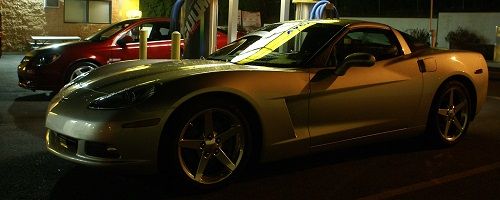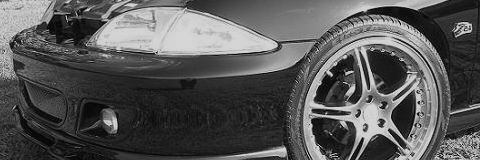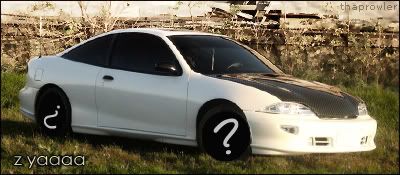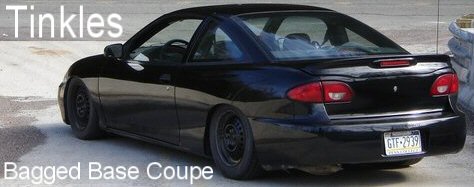so... this is interesting.. was wondering if anybody noticed this:
 Wilwood GM Metric calipers
Wilwood GM Metric calipers
Wilwood's GM Metric Caliper is a direct replacement for the 1978 and later D154 type GM metric caliper. Weighing in at a mere 2.97 pounds, it provides a substantial weight savings over cast iron OE calipers.
This competition caliper represents the latest refinements in caliper design and manufacturing through the use of computer based FEA solid modeling and stress simulation programs. The real strength of this caliper comes from its triple bridge configuration, and its lightness is a result of efficient design.
Mounting Dimensions
GM Metric Caliper Pads
The triple bridge provides higher clamping efficiency through lower deflection over all twin bridge models. All load bearing and stress points are fortified to maximize strength, and all unnecessary material is removed to maximize weight reduction. The results are the strongest, lightest, and most efficient aluminum caliper in its class.
The caliper body is a precision casting using a tight grained, high density aircraft alloy. Stainless steel pistons provide improved fluid protection with high resistance to corrosion and low heat transfer. Each caliper is fully machined, assembled with high temperature seals, and tested in-house by expert Wilwood technicians to assure top quality and peak performance - the kind of quality and performance you expect from Wilwood.
 Wilwood GM3 calipers
Wilwood GM3 calipers
Wilwood's GM III caliper represents the latest refinements in caliper design and manufacturing through the use of solid modeling and stress simulation programs. The result is the most rigid, highest torque, lightweight aluminum caliper in its class.
The real strength comes from its exclusive triple bridge configuration which provides a tremendous increase in clamping force over other twin bridge calipers. Efficient designs further maximize weight savings: Material is properly placed to fortify all load bearing points.
Mounting Dimensions
GM III Caliper Pads
Each caliper model has its own unique casting: 2.38" diameter piston calipers incorporate a smaller external contour than the larger 2.75" diameter piston calipers. Any material that did not contribute to strength, was eliminated for weight reduction, resulting in a caliper that weighs just over three pounds.
The GM III incorporates standard Wilwood features like stainless steel pistons for increased fluid protection and high temperature seals for controlled retraction which provides improved driver feel. The GM III for 1.00" width rotor is machined and fitted with OEM type slide pin vibration dampeners for a direct OEM caliper interchange.
These tight grained, high density aircraft alloy aluminum castings are fully machined, assembled and tested in-house by fully trained technicians at Wilwood to assure top quality and peak performance.
I'm wondering if either of these calipers are a direct bolt-on for the Jbody. Seeing as that would be a MAJOR weight savings per corner it might be something worth looking into.
so if anybody can save me the trouble of measuring up my stock calipers, I'd appreciate it. if not.. I'm def going to be taking a tape measure to mine and comparing to the drawings on wilwoods site.
This would be a hardcore advantage for people looking to upgrade their OEM diameter brakes slightly will retaining the ability to run 15" diameter rims for drag purposes such as myself. Not to mention ultra light weight calipers... HELL YEA!
maybe lenko can give insight as to which design (GM3 or GMmetric) is the jbody caliper...


indeed......i want in on this kinda

swapped, supercharged, intercooled, 2.9, fun
No way in hell.
I've done way too much research on every single wilwood caliper they make (at least, f/s to the public). Do some research on the knuckle that those calipers bolt to and you'll see why.
-----------------------------------------------------------------------

-----------------------------------------------------------------------
- Sold my beloved J in April 2010 -
never hurts to measure....
Viper98912 wrote:No way in hell.
I've done way too much research on every single wilwood caliper they make (at least, f/s to the public). Do some research on the knuckle that those calipers bolt to and you'll see why.
if you could fill me in i'd really appreciate it.. thats sorta the point of this thread
I'm having difficulty finding applications for these calipers and information on the caliper design of the jbody.. although I didn't do a search on the org itself, I was searching through google and some other websites trying to find information on our calipers and turned up diddly

There's nothing really that can be done with the stock brakes. I tried.

Anyway, here's a picture.

If you look closely, the pads ride along the bolts. The bolts go through some holes, and then there's a set of ears that push up against the caliper. It's this set that's most important because it pushes back on the caliper, keeping it from spinning around and shearing the bolts.
In our car, the ears hold the pads, and there's no good way to make it change over.
Also, the bolt holes don't line up and there's not enough room to try to safely redrill new ones anyway.
go nwf.
-----------------------------------------------------------------------

-----------------------------------------------------------------------
- Sold my beloved J in April 2010 -
So the pads that are intended to be used with these use bolts to hold them? How does that stop you from actually bolting the caliper to the spindle? Our stock pads don't make any contact with the spindle, so I guess I'm not understanding why these wouldn't work. Do you still have the measurments of the stock caliper lying around?
This one will most likely fit H body spindles-
Quote:
The GM III for 1.00" width rotor is machined and fitted with OEM type slide pin vibration dampeners for a direct OEM caliper interchange.


Our pads do make contact with the spindle - the ears.
Basically, these stock calipers (and their subsequent bolts) do not take the force of the braking (this is different when going to large block-style calipers, like most wilwoods, brembos, etc). The pads rest on something, that later puts force on something else. In our Jbody case, the pads rest on the ears of our spindle, and the caliper essentially floats on our pads (even though it's deceiving because the pads clip into our calipers). In the D154 case, the pads bolt to the caliper, but then the caliper is restrained by two ears to take the load. If not, in both cases, you'd run a risk of shearing the mounting bolts.
-----------------------------------------------------------------------

-----------------------------------------------------------------------
- Sold my beloved J in April 2010 -
Can't we just run 10.9 bolts to counter-act this?
--------------------------------------------------------
2002 Sunfire -->
- Ractive steering wheel
- ASA 17" EM9 + Nexen N5000 215/45/17 (steelies for winter)
- D-Spec Lowering kit @ 1.4" (issues currently

)
- Rockford P250.1 + MTX MZS1004 + Panasonic CQ-C8313U head unit
- Barely legal tint.

the pin/bolt is one piece, and its not just like you go to home depot and find some.
-----------------------------------------------------------------------

-----------------------------------------------------------------------
- Sold my beloved J in April 2010 -
Crap.

--------------------------------------------------------
2002 Sunfire -->
- Ractive steering wheel
- ASA 17" EM9 + Nexen N5000 215/45/17 (steelies for winter)
- D-Spec Lowering kit @ 1.4" (issues currently

)
- Rockford P250.1 + MTX MZS1004 + Panasonic CQ-C8313U head unit
- Barely legal tint.

So....I have SSBC rear disc coversion now...would these bolt up to that set up?
HMMMMMMMMM????
I mean it's not the cheapest way to go....but if you could run the same rotor in the rear...this caliper....I'd have a matched set of disc brakes!
Edited 1 time(s). Last edited Friday, April 18, 2008 1:06 PM
Eh...old man with a Corvette now...it was bound to happen sooner rather than later right?
listening....

Rollin' on question marks since 07.
Viper98912 wrote:Our pads do make contact with the spindle - the ears.
I totally forgot about the slides (ears). I did some more research into this. These calipers are direct replacements. The ones they replace look just like this, without the lightening. They operate the same way (pins, and not ears), and are used on some larger cars, so I don't see why the pin setup is any less reliable than the ear setup. I found about 100 places that sell "race" calipers that are the equivalent of these, with all sorts of piston diameters. They all bolt right up in place of the factory stuff, and they all have the pins instead of the ears. These two calipers are pretty popular with the circle track crowd.
Info (with FMSI numbers)-
GM metric caliper- D154 (OEM 82-92 F body w/o 1LE)
GM III caliper- D052 (1971-81 Camaro, 1966-77 Chevelle, 1969-78 Firebird, 1971-95 1/2 ton & 3/4 ton vans, 1981-91 1/2 ton Suburbans, plus some others)
Stock J body 92+ caliper- D0506
Stock H body caliper- D0505 (used on early 90s mid sizes and F bodies)
Neither of these will bolt up, even with the NWF swap, since the 4th gen F body calipers are different (D749). So, I just repeated what viper said about fitment

, but my school of thought about the pins vs ears is different.


Yea, I've got "ears" stuck in my head (no pun intended) because I think its the wilwood kit that says "cut off the ears" or something.

As for the technical term, it escapes me at this time.
As for less reliable, the pins alone are fine, but as a complete setup, they need the extra support. Look at the thickness and shape of the Jbody's ears, and any other car that uses a pad-on-ear design and then compare that with a pin, and tell me what you think and if you think it can support the rotational load. Same thing goes with a pad-in-bracket design, where the bracket is thick.
-----------------------------------------------------------------------

-----------------------------------------------------------------------
- Sold my beloved J in April 2010 -
I think I understand what you're saying....
I would still pick the pin design over the ear design. A forged pin is stronger than a cast ear any day. Thats how Wilwood attaches their big brake kits, the adapter bracket is nothing more than 4 pins (well, 2 bolts and 2 studs, same thing though). I think the drawback is that it costs more to produce a forged pin, and thats why GM switched to the ear design ~ early 90s. If there was a way to add some more meat to the caliper mounting bosses on our spindles (if the bolt pattern was correct) to support the added stress, then I think this would work just fine.


IF there was a way....
-----------------------------------------------------------------------

-----------------------------------------------------------------------
- Sold my beloved J in April 2010 -
James Cahill wrote:GM III caliper- D052 (1971-81 Camaro, 1966-77 Chevelle, 1969-78 Firebird, 1971-95 1/2 ton & 3/4 ton vans, 1981-91 1/2 ton Suburbans, plus some others)
Thanks alot, you just hopefully found me calipers for my project truck.




















